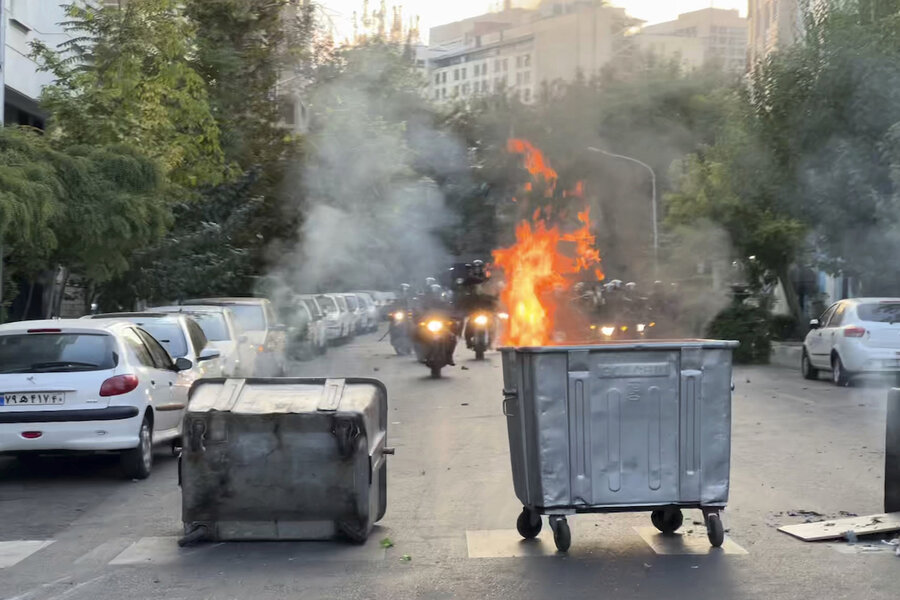Protests continue in Iran after hijab arrest results in death
Loading...
Protests have erupted across Iran in recent days after a 22-year-old woman died while being held by the morality police for violating the country’s strictly enforced Islamic dress code.
The death of Mahsa Amini, who had been picked up for her allegedly loose headscarf, or hijab, has triggered daring displays of defiance, in the face of beatings and possible arrest.
Many Iranians, particularly the young, have come to see Ms. Amini’s death as part of the Islamic Republic’s heavy-handed policing of dissent and the morality police’s increasingly violent treatment of young women.
Here’s a look at what sparked the protests and where they might lead.
What’s happening in Iran?
In street protests, some women tore off their mandatory headscarves, demonstratively twirling them in the air. Videos online showed two women throwing their hijabs into a bonfire. Another woman is seen cutting off her hair in a show of protest.
At some of the demonstrations, protesters clashed with police and thick clouds of tear gas were seen rising in the capital, Tehran. Protesters were also chased and beaten with clubs by the motorcycle-riding Basij.
The Basij, volunteers in Iran’s paramilitary Revolutionary Guard, have violently suppressed protests in the past, including over water rights and the country’s cratering economy.
Yet some demonstrators still chant “death to the dictator,” targeting both Supreme Leader Ayatollah Ali Khamenei and Iran’s theocracy, despite the threat of arrest, imprisonment, and even the possibility of a death sentence.
What caused the protests in Iran?
Iran’s morality police arrested Ms. Amini on Sept. 13 in Tehran, where she was visiting from her hometown in the country’s western Kurdish region. She collapsed at a police station and died three days later.
Police detained her over wearing her hijab too loosely. Iran requires women to wear the headscarf in a way that completely covers their hair when in public. Only Afghanistan under Taliban rule now actively enforces a similar law. Ultra-conservative Saudi Arabia has dialed back its enforcement over recent years.
The police deny Ms. Amini was mistreated and say she died of a heart attack. President Ebrahim Raisi, who will speak at the U.N. General Assembly on Wednesday, has promised an investigation.
Ms. Amini’s family says she had no history of heart trouble and that they were prevented from seeing her body before she was buried. The demonstrations erupted after her funeral in the Kurdish city of Saqez on Saturday, and quickly spread to other parts of the country, including Tehran.
How are women treated in Iran?
Iranian women have full access to education, work outside the home, and hold public office. But they are required to dress modestly in public, which includes wearing the hijab as well as long, loose-fitting robes. Unmarried men and women are barred from mingling.
The rules, which date back to the days after the 1979 Islamic Revolution, are enforced by the morality police. The force, officially known as the Guidance Patrol, is stationed across public areas. It is made up of men as well as women.
Enforcement was eased under former President Hassan Rouhani, a relative moderate who at one point accused the morality police of being overly aggressive. In 2017, the head of the force said it would no longer arrest women for violating the dress code.
But under Mr. Raisi, a hard-liner elected last year, agents of the morality police appear to have been unleashed. The U.N. human rights office says young women have been slapped in the face, beaten with batons, and shoved into police vehicles in recent months.
How has Iran responded to the protests?
Iranian leaders have vowed to investigate the circumstances of Ms. Amini’s death while accusing unnamed foreign countries and exiled opposition groups of seizing on it as a pretext to foment unrest. That’s been a common pattern during protests in recent years.
Iran’s ruling clerics view the United States as a threat to the Islamic Republic and believe the adoption of Western customs undermines society. Mr. Khamenei himself has seized on so-called “color” protests in Europe and elsewhere as foreign interventions – and not as people demonstrating for more rights.
Tensions have been especially high since then-President Donald Trump withdrew from the 2015 nuclear deal with Iran and imposed crippling sanctions. The Biden administration has been working with European allies for the last two years to revive the accord. The negotiations appear deadlocked, as nonproliferation experts warn Iran has enough highly enriched uranium for a nuclear bomb if it chooses to build one. The Islamic Republic insists its program is peaceful.
The governor of Tehran said Wednesday that authorities arrested three foreign nationals at protests in the capital, without elaborating. Iranian security forces have arrested at least 25 people, and the governor of the Kurdistan province says three people have been killed by armed groups in unrest linked to the protests, without elaborating.
Activists and human rights groups have blamed Iranian security forces for killing protesters in other demonstrations, like those over gasoline prices in 2019.
Could the protests bring down Iran’s government?
Iran’s ruling clerics have weathered several waves of protests going back decades, eventually quashing them with brute force.
The most serious challenge to the clerics’ rule was the Green Movement that emerged after the country’s disputed presidential election in 2009 and called for far-reaching reforms; millions of Iranians took to the streets.
Authorities responded with a brutal crackdown, with the Revolutionary Guard and the Basij militia opening fire on protesters and launching waves of arrests. Opposition leaders were placed under house arrest.
Among those killed was Neda Agha Soltan, a 27-year-old woman who became an icon of the protest movement after she was shot and bled to death in a video seen by millions on social media.
This story was reported by The Associated Press.







